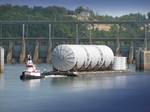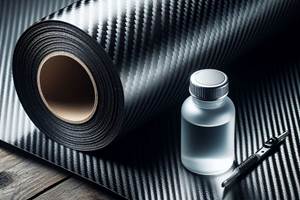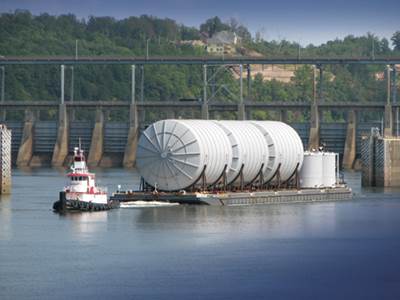Building a better corrosion-control composite
Many FRP products used in corrosive environments — pipe, tanks, ductwork, stack liners and so forth — are constructed with filament winding or pultrusion processes and contain 60 to 70 percent glass fiber reinforcement by weight.
When it comes to corrosion, the diversity of the applications and corrosive elements requires a number of resin chemistries and the proper selection from many fiber reinforcements the one best suited for each environment. Many FRP products used in corrosive environments — pipe, tanks, ductwork, stack liners and so forth — are constructed with filament winding or pultrusion processes and contain 60 to 70 percent glass fiber reinforcement by weight.
In corrosion-control applications, part construction requires that the structural portion of the laminate, which supplies the majority of the strength and stiffness of the part, be protected from direct exposure to corrosive contents by a corrosion barrier. The barrier is resin-rich and typically consists of an inner surface veil backed by a mat of either chopped strand mat or chopped roving. For example, when RL Industries (Fairfield, Ohio) constructed three composite tanks for a chemical plant in Saudi Arabia, intended for storage of a 32 percent solution of hydrogen chloride or a 20 percent solution of sodium hydroxide, cylindrical sections of glass roving impregnated with AOC LLC’s (Collierville, Tenn.) Vipel resin were filament wound over a corrosion barrier formed with chopped strand glass mat and two layers of carbon fiber veil. Nozzles and attachment features for the ladders and rails were integrated into the wound sections. Top and bottom end enclosures, vacuum-infused with glass reinforcement and structural sandwich core, also were integrated during the winding process. Tank sections were assembled on site, using laminating techniques similar to those used to join chimney liner sections.
According to Reichhold (Durham, N.C.), which supplies its Dion anticorrosion resins to the market, “corrosion barriers are typically 100 to 125 mils thick and consist of a surfacing veil saturated to a 90 percent resin content, followed by the equivalent of a minimum of two plies of 1.5- to 2.0-oz/ft2 chopped strand mat impregnated with approximately 70 percent resin. The structural portion of the laminate can be sprayed up/hand layed with chopped strand mat, chopped roving or chopped strand mat alternated with woven roving, or it can be formed by filament winding. An additional ply of mat is sometimes used as a bonding layer between a filament-wound structural overwrap and the corrosion barrier.” A resin-rich topcoat also is commony used to guard against UV degradation and exterior corrosion.
A variety of fiber reinforcements — including E-glass, C-glass, E-CR glass and carbon — are used in corrosion-control laminates. E-CR glass, a boron-free fiber manufactured specifically to resist acid and alkali exposure, is widely used in the veils and structural layers of corrosion-control laminates, especially in chemical processing applications.
It’s critical to choose the correct fiber for each environment. When a corrosive chemical comes in contact with a glass fiber, via a microcrack or some other small failure of the corrosion barrier, use of the wrong glass fiber type could lead to chemical degradation of the fiber and eventually destroy the resin bond, resulting in laminate failure.
Traditional E-glass does not stand up well to most chemical incursions. “When immersed in 5 percent hydrochloric acid for two hours at 80°C/27°F, elements of the E-glass fiber are leached and replaced with hydrogen,” explains Kevin Spoo, a research associate at Owens Corning Composite Materials (Toledo, Ohio). This results in a porous layer that is more easily cracked under stress. E-CR glass contains no boron, however, so under similar conditions, it resists leaching. Owens Corning’s Advantex brand glass, developed in 1996, is a boron-free glass formulation that mixes E-CR glass and a boron-free, modified E-glass fiber reinforcement. The resulting reinforcement reportedly has increased mechanical properties compared to standard E-CR and E-glass.
Another option comes from PPG Fiber Glass (Pittsburgh, Pa.), which recently released INNOFIBER CR, a boron-free modified E-glass designed to reinforce polyester, epoxy and vinyl ester resin systems in pultrusion and filament winding applications, as well as multiaxial weaving. According to PPG, INNOFIBER CR can be used in the laminate portion and the corrosion barrier of a structure. The company’s HYBON 2002 CR roving, a continuous filament, single-end roving product, meets ASME D-578 Section 4.2.2 standards for E-glass and Section 4.2.4 standards for E-CR glass.
Related Content
Composite resins price change report
CW’s running summary of resin price change announcements from major material suppliers that serve the composites manufacturing industry.
Read MoreComposite Integration presents webinar on liquid resin infusion
On July 30, 2025, company experts will discuss the role of LRI in delivering scalable, OOA composite production for the aerospace sector.
Read MoreClean Aviation's regional aircraft technology testbed #2 demonstrates advances with composites
European project advances OOA outer wing box using resin infusion and thermoplastic composite technologies.
Read MoreCOMPINNOV TP2 project promotes use of thermoplastics in aerospace
Completed in 2023, COMPINNOV TP2 explored thermoplastic composites, enhancing the understanding between prepregs and production methods to foster the potential for French aerospace innovation.
Read MoreRead Next
Industrial corrosion control: Huge opportunities
Fiber-reinforced plastic is the ideal but still widely ignored option in environments that eat away at most metal alloys. Opportunities abound, but the key is still education.
Read MoreCutting 100 pounds, certification time for the X-59 nose cone
Swift Engineering used HyperX software to remove 100 pounds from 38-foot graphite/epoxy cored nose cone for X-59 supersonic aircraft.
Read MoreNext-gen fan blades: Hybrid twin RTM, printed sensors, laser shock disassembly
MORPHO project demonstrates blade with 20% faster RTM cure cycle, uses AI-based monitoring for improved maintenance/life cycle management and proves laser shock disassembly for recycling.
Read More











